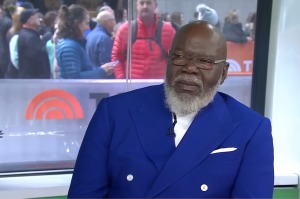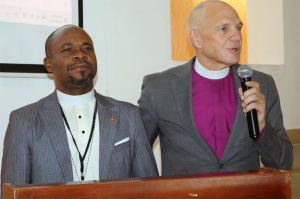A New Church for the New America: The Big Stretch of the Multiethnic Church (Pt. 3)
"There are no people here anymore."
The line was a shocker. The church leader was explaining to my wife and me why his congregation was selling its massive church facility and moving away. Yet we could see hundreds of houses, all full of human beings. But to reach them required a stretch he and the congregation couldn't even conceive.
The conversation occurred in a transitional Deep South community in the late 1960s. My wife and I still wince when we recall it. Back then the issue was important. Now, however, it is critical for the shaping of the new church that can minister effectively to the new America.
The old demographic is fading, and with it the worldview consensus that valued Judeo-Christian values even if it did not consistently embrace and apply them. G.K. Chesterton said the old America was "a nation with the soul of a church."
The rest of the country may not have experienced the scope of demographic change that we have in Houston, but ultimately all America will feel the impact through worldview shifts in new voting, social, cultural, and philosophical patterns.
Early immigrants came from the "Christian" West and therefore shared the biblical worldview. "Providence has been pleased to give this one connected country to one united people – a people descended from the same ancestors, speaking the same language, professing the same religion, attached to the same principles of government…" wrote John Jay in The Federalist.
Like it or not, that country is dying. Churches as well as political parties, educational institutions, business, and individuals must make the necessary changes to minister effectively in new America.
In Part 2, I noted three important principles gleaned from serving in Houston, the nation's most cosmopolitan city, for 28 years:
1. The multiethnic attitude and style must not be contrived.
2. The multiethnic church must not be merely a patronizing institution, but cultivate the cross-ethnic, cross-cultural lifestyle.
3. The multiethnic church must also be multicultural.
Here are four more keys to developing the multiethnic church:
4. The multiethnic church must be guided and inspired by a vision that answers the essential questions.
The core vision questions are: How close can you see? How far can you see? How wide can you see? How narrow can you see?
A church stretching into multiethnic lifestyle must see "close". It must understand its base, and how far it can be stretched in any one phase. Such a congregation must have a clear understanding of resources already present to help it through the transition.
Seeing "far" means looking into the future. Ed Young, under whom I serve, tells our staff constantly, "we are preparing for those not here yet."
Seeing "wide" means scoping out the entire demographic of a church's community. It means not jumping to the conclusion that there "are no people here anymore." Rather, seeing "wide" is to ask the strategic question: "How can we reach and minister to everyone in our community?
Seeing "narrow" means not sacrificing doctrine for style, truth for platitude, depth for superficiality, or genuiness for pretense.
5. The developing multiethnic church must see itself as a learning organism.
"What can they learn from us?" must not be the only question for a church stretching into multiethnicity. "What can we learn from them?" is greatly important.
Governments will concern themselves with how to manage immigration. The church should consider the larger question of why God is placing newcomers into its community. Certainly it is to bring people to Christ. But it is also so that Christians can learn to be a Kingdom community, and not a mere nationalistic institution, as noted in Part 1.
Out multiethnic experience in Houston has been enriched by prayer styles of immigrants from Africa, worship expressions ministered through Hispanics and Latinos, passion for missionary outreach inspired in and through Asians, the example of unwavering commitment seen in people who have come to us from lands where Christians are persecuted severely. Plus, we have had to learn to speak new languages, discover fresh idioms, grasp contextual matrices of which we were ignorant.
6. The multiethnic ministry lifestyle must permeate at every level.
Andy Warhol said that everyone will have their 15 minutes of fame. In our media-driven, photo-op culture it's easy to succumb to the temptation to be merely cosmetic. The quota-mentality rather than the multiethnic outlook drives a cosmetic congregation.
The true multiethnic church discerns spiritual gifts rather than merely displays race. It sees leadership giftings, pastoring graces, teaching capacities, evangelistic anointings, exhortation-encouragement ministries, helps and mercy callings and abilities. The spiritual gifts are spread across the congregation, irrespective of race and gender. As they are released into the body multiethnicity permeates.
I am a five-foot, eight-inch, 72-year old white man raised in the segregation-era Deep South. The director of a class I teach at our church is a six-foot, four-inch (at least) black man who is a Colonel in the United States Army, and holds a doctorate in education. No one could have contrived such a partnership, but in the church that values and discerns spiritual gifts rather than cosmetics, such a (super)natural partnership "happens".
7. Though we live in a hyphenated society the multiethnic church must not be a hyphenated body.
Hyphenation entered the church early. There were Hebrew-speaking widowed Christians, and Greek-speaking widowed Christians. There were "Paul-Christians", "Apollos-Christians", and "Cephas-Christians". (1 Corinthians 1:12) There were Law-observant Christians and Grace-focused Christians.
Paul himself saw these as marks of immaturity and "fleshly" living, though all the schismatics might have been well-intentioned. But factionalism resulted, with the weakening of the body.
"There is no room in this country for hyphenated Americanism," said Teddy Roosevelt long ago. That warning is even more important for the church in a culture that accentuates and takes pride in hyphenation.
Cultures and fads of a society must never drive theology. The stretching church must not become the plastic church, accommodating all trends, merely holding to the "nationalisms" of the moment rather than transcendent biblical doctrine.
The multiethnic church communicates that ages-old truth in a variety of styles to "find common ground with everyone" to "bring them to Christ." (1 Corinthians 9:22 NLT) And that's the point of if all: to bring them to Christ.





























